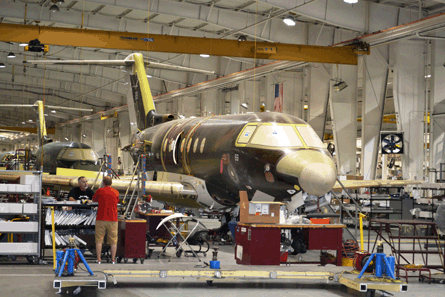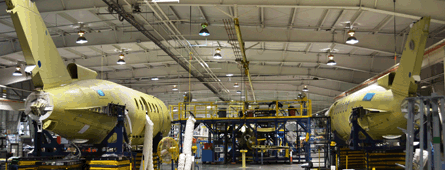Nowhere is the transformation of the embattled Hawker Beechcraft of old into the lean, mean Hawker of today more evident than on the tidy grey floor of Plant 4, final assembly building for the Wichita-based company's civil products.
It is here that Bill Brown, executive vice-president of global operations, has cut the time and money it takes to build an aircraft. Brown took on the role in 2009, leaving his former position as president of global customer support.
His move was part of a broad retooling that began in 2009 with the hiring of former Gulfstream and NetJets leader Bill Boisture as chairman and chief executive of the Goldman Sachs and Onex-owned company. Boisture came in at a tough time, witnessing a 40% reduction in deliveries (160 business jets in 2008; 98 in 2009) and the loss of 1,500 jobs (7,500 to 6,000).
 |
|---|
© John Croft/Flightglobal |
This forced Hawker Beechcraft to implement a strategic plan that yielded $200 million in sustainable cost reductions in 2009.
The company is seeking another $200 million in savings through lean manufacturing, changes to facilities and reductions in footprint. "We have undertaken significant transformational work around supply chain, engineering and operations," says Shawn Vick, executive vice-president. "We've organised functions like finance and human resources to support the transformation within the business, as well as to support our 'go-to' market strategy. The next big step is continued improvement in the marketplace, which will mean increased volumes that we can act upon very quickly."
Brown's work will play a big part in that response. Along with making the production facility more efficient, he had to build a bond between management and workforce. Relations had been strained in years past, partly due to the transfer of certain sheet metal and electrical assembly work to Hawker's plant in Chihuahua, Mexico.
The factory setup was not optimal when Brown took over in 2009. "Everything was put [where it was] because there was a hole there - it wasn't organised," he says. "We needed to do it differently for lean manufacturing. We needed an aggressive reduction in the number of people needed to build an aircraft."
First and foremost in the new way of doing business was quality - a focus that itself would bring all the other necessary ingredients, such as reliability and lower cost of manufacturing, says Brown. A quality focus involved the people, processes and equipment at the plant.
For the people, Brown began sending employees to training programmes conducted by Insigniam Performance, not teaching employees how to build aircraft but focusing on mindset and behaviour - elements needed to build trust with other workers and management. "Some [Plant 4] employees worked here 20 years with each other and didn't know each other," says Brown. He says 1,500 employees have been trained so far.
Brown gives an example of waste that was corrected. When green aircraft would go out for paint, the painters would remove and reapply the sealant that Plant 4 workers had applied, because it had not been done the way the painters needed it to be. "The paint people didn't talk to the build people," says Brown.
The changes in attitude, along with optimal production line flow, have produced some amazing results. On the combined Hawker 750 and Hawker 900XP line, build time has been slashed to 5,000 man hours today, from 8,000h in 2009 - a 38% reduction.
 |
|---|
© John Croft/Flightglobal |
A companion metric, the "cost of quality" - the wasted cost of scrap, repair and rework during the build - is down to $4,000-5,000 from $80,000 per aircraft, says Brown. "We cut waste [by] 89% the first year," he adds. The next goal for Hawker 750/900 production time is a build time of 4,850h.
For the composite-fuselage Hawker 4000, which is built on the same line as the Premier 1A, build time has been reduced from 40,000h per aircraft to 15,000h. The goal is to further trim the time to 12,500h. Brown says workers have cut the cost of quality by more than 50%, or more than $1 million per aircraft. And an off-line tool Hawker developed to build a Hawker 4000 belly fairing - once done by workers in place under the aircraft - saved 800 man hours. Next year, Brown says, Hawker will begin deploying robots to mark the insides of composite fuselage barrels for equipment connections - done by hand today. He says these will cut 400 man hours in build time, per aircraft.
For the King Air line, lean initiatives have cut labour hours by 23%, from 2,700h per aircraft to 2,000h. The target is 1,450h.
Brown says workers determined that they could save time on installing insulation blankets in the cabin if manufacturer Goodwill Industries put codes on the pieces so workers would know the installation position without reading the part number.
The Rockville, Maryland-based company not only agreed to stamp the code, but offered to box the blankets by zone, saving time in the receiving and installing processes. It said it could make better blankets if Hawker could provide better templates, which the airframer did. "There are at least 100 similar cases," says Brown.
On the piston-powered Bonanza and Baron line, production was brought over to Plant 4 from a different building eight months ago, resulting in a 30% reduction in build time, says Brown. While Hawker charges the same price for the aircraft, he says the firm earns $100,000 more per unit, "getting us closer to the break-even point for our costs".
Despite faster production, quality is increasing, in part due to better communication between technicians and engineers, who now have desks in the plant. "Engineering was a bit of an ivory tower here before, and not integrated with [the] business," says Heidi McNary, vice-president and chief technical officer of Hawker Beechcraft product development and engineering. She recalls that about half the company's 700 engineers were excited about deploying, but "with the other half there was a bit of kicking and screaming".
A mentoring programme links the engineers who have decades of experience with those who do not. "Most of our guys appreciate that if we don't have more of the critical skills, it will be difficult [for Hawker Beechcraft]," says McNary.
One of her focus areas over the next year is to set a goal "for the organisation to be more agile, flexible and entrepreneurial," she says. That partly means standardising "tribal knowledge" associated with heritage product lines. "It has proven more difficult than it should be to move from one line to another based on tribal knowledge," she says. "We've been establishing what is the Hawker Beechcraft way. The 'getting up to speed' time needs to be a lot faster."
To standardise on the production floor there is what Brown calls his "metrics board" - a four-sided billboard and library of sorts - several of which are placed along each assembly line. Included on the board are safety metrics and a library holding colour-coded manuals for workmanship standards, such as the proper way to countersink a rivet. There are several quality goals - one is to have no 'QNs', or quality notifications, at any station along the production line during a build. A second is to have a "perfect airplane" at delivery, meaning the new owner finds no issues during the pre-buy inspection.
While Hawker has delivered 45 "perfect" aircraft so far this year, including three Premiers - Brown says there were not any perfect Premiers until this year - there continue to be QNs issued at the end of various stages during builds, increasing the build time when the problems have to be fixed later. "We're hoping for one QN-free aircraft by year's end," says Brown.
Source: Flight International
















